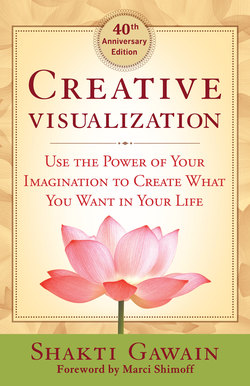Читать книгу Creative Visualization - Shakti Gawain - Страница 17
На сайте Литреса книга снята с продажи.
ОглавлениеHOW TO VISUALIZE
Many people wonder exactly what is meant by the term “visualize.” Some worry because they don’t actually “see” a mental picture or image when they close their eyes and try to visualize. When some people first try to visualize, they feel that “nothing is happening.” Usually, they are simply blocking themselves by trying too hard. They may be feeling that there’s a “right way” to do this, and that their own experience is incorrect or inadequate. If this is how you feel, you need to stop worrying, relax, and accept what happens naturally for you.
Don’t get stuck on the term “visualize.” It is not at all necessary to mentally see an image. Some people say they see very clear, sharp images when they close their eyes and imagine something. Others don’t really “see” anything; they sense or feel it, or they just sort of “think about” it. That’s perfectly fine. Some people are more visually oriented, some are auditory, others are more kinesthetic. We all use our imaginations constantly — it’s impossible not to, so whatever process you find yourself doing when you imagine is fine.
If you still don’t feel sure what it means to visualize, read through each of these exercises, then close your eyes and see what comes naturally to you:
Close your eyes and relax deeply. Think of some familiar room such as your bedroom or living room. Remember some familiar details of it, such as the color of the carpet, the way the furniture is arranged, how bright or dark it is. Imagine yourself walking into the room and sitting or lying down on a comfortable chair, couch, or bed.
Now recall some pleasant experience you have had in the last few days, especially one involving good physical sensations such as eating a delicious meal, receiving a massage, swimming in cool water, or making love. Remember the experience as vividly as possible, and enjoy the pleasurable sensations once again.
Now imagine that you are in some idyllic country setting, perhaps relaxing on soft green grass beside a cool river, or wandering through a beautiful, lush forest. It can be a place that you have been, or an ideal place where you would like to go. Think of the details, and create it any way you would like it to be.
Whatever process you used to bring these scenes to your mind is your way of “visualizing.”
There are actually two different modes involved in creative visualization. One is receptive, the other is active. In the receptive mode we simply relax and allow images or impressions to come to us without choosing the details of them; we take what comes. In the active mode we consciously choose and create what we wish to see or imagine. Both these processes are an important part of creative visualization, and both your receptive and active abilities will be strengthened through practice.
Special Problems with Visualization
Occasionally a person has completely blocked his ability to visualize or imagine at will, and feels that he simply “can’t do it.” This type of block usually arises from a fear, and it can be worked through if the person who experiences the difficulty desires to solve the problem.
Usually a person blocks his ability to use creative visualization out of a fear of what he may encounter by looking inside himself — fear of his own unacknowledged feelings and emotions.
For example, a man in one of my classes was consistently unable to visualize, and kept falling asleep during the meditations. It turned out that he had once had a profoundly emotional experience during a visualization process, and he was afraid he would be embarrassed by becoming emotional in front of others.
A woman client of mine had difficulty visualizing until she went through therapy and was able to get in touch with, experience, and release painful feelings that she had buried inside since childhood.
The truth is that there is nothing within us that can hurt us; it is only our fear of experiencing our own feelings that can keep us trapped.
If anything unusual or unexpected arises during meditation, the best thing is simply to look at it fully, be with it and experience it as much as you can, and you will find that it eventually will lose any negative power over you. Our fears arise from things we don’t confront. Once we are willing to look fully and deeply at the source of a fear, it loses its power. If we feel overwhelmed, it can be very helpful to get support from a good counselor or therapist who can help us accept and express our feelings. This is especially important if we’ve had a lot of pain or trauma in our lives.
Fortunately, problems with visualization are relatively rare. As a rule, creative visualization comes naturally, and the more you practice it, the easier it becomes. If visualization is difficult for you, you may find that saying affirmations is easier and more effective (see later chapters).
